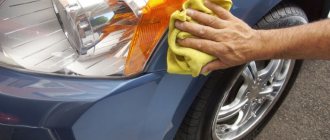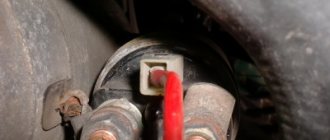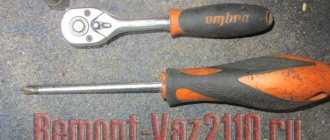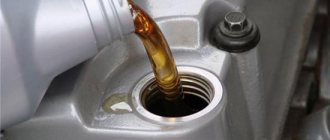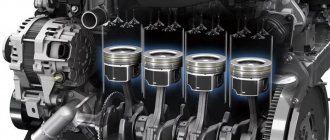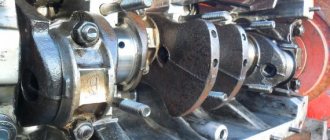Long-term storage of a car requires a competent preservation procedure, which includes draining technical fluids or replacing them with suitable compounds. If this is not done, then the working fluids lose their properties, rubber products dry out, parts become corroded, etc. It is quite obvious that an unprepared car will need to be restored after 2-3 years of parking.
A vehicle that has been idle for a long time (6 months or more), which has not been prepared in advance for such parking and has not undergone a preservation process, may require some preparation before starting the engine. Additionally, it is necessary to take into account the parking time, seasonality and conditions in which a particular vehicle is located.
Possible breakdowns
It should be immediately agreed that the term “long downtime” is a relative concept. Therefore, we will separately consider starting the engine after different periods of parking, including long-term storage of the car. After parking the car for a long time, the following negative factors may appear:
- Battery discharge.
- Oxidized contacts.
- The piston rings are stuck in the pistons.
- Air penetration into the power supply system of diesel power units.
- Evaporation of gasoline from the carburetor body, or draining of fuel from the tank.
In addition to these well-known situations, you can also see the consequences of animal life. Even drivers who constantly use their cars may find that hoses or wires have been chewed by rats. There is a possibility that after such parking the car will not start for a long time.
Possible problems
The car will not simply refuse to start; this is facilitated by factors whose influence increases as the idle time increases. Here are the main circumstances:
- battery is low;
- air entering the fuel system (typical for diesel engines);
- occurrence of rings in the pistons;
- oxidation of contacts;
- evaporation of fuel from the carburetor.
In addition, fuel can simply be drained from the tank by thieves, who often prey on cars that have been idle for a long time.
A special word should be said about living creatures: rats and large mice chew through wires and hoses, as a result of which serious repairs are required. There are known cases when birds and even small reptiles make their nests under the hood of idle cars. However, as a rule, there is no particular harm from such representatives of the fauna.
Parking up to one month
A serviceable car should start without problems after such parking, since the main malfunction of the car in such situations is a discharged battery. Therefore, we must take into account its seasonal features. Even in cold weather at -15 degrees, idle time for 10 days often leads to battery discharge. In warm weather, the battery can only be discharged due to current leakage, the rate of which should not be more than permissible. Signs that make it clear that the engine will not start due to the battery are the following:
- When the ignition is turned on, the indicators on the instrument panel do not light up.
- When you try to start the engine, you hear a small click.
- The starter slowly rotates the engine crankshaft.
You will need to charge the battery using a special device for charging car batteries, or seek help from outside drivers. To start the engine, you need starting clamps - “crocodiles”, as well as knowledge of the rules for “lighting” from an external power source. If your car has a manual transmission, then it can be started using a pushrod.
Starting a diesel engine will require significant effort, so not all cars equipped with a diesel engine can be started in this way without consequences, so it is better to avoid this method.
Battery
The condition of the battery is considered an important condition for trouble-free starting if there is no kickstarter (relevant for progressive scooters with large cubic capacity). A battery “lighted” through the wires will help, but will not give the same result as a well-charged scooter battery in advance. Not to mention the fact that a self-discharged battery over the winter will not crank the engine, it will also not provide suitable voltage to the “brains” (if any), which, because of this, will categorically refuse to work correctly and give a spark.
Let me remind you that it is preferable to charge the battery with a current of 10% of the rated capacity for 10 hours, i.e. It is better to charge a battery with a capacity of 9 A/h with a current of 0.9 A for 10 hours. The appropriate charging current is marked on the battery cover.
Thus, first of all, to start the moped in winter. We unscrew the spark plug - if it’s dry, then it’s a fuel problem.
Before screwing the spark plug back in, you should check the spark. To do this, insert the spark plug into the cap and, ensuring that its threaded part is in contact with the ground (engine body, frame), turn the crankshaft with a sharp movement. Of course, you can use the emergency option and hold the cap with your hand, but it is better to use a piece of wire, one end of which is screwed to the motor body, and the other to the threaded part of the spark plug. If there is no spark, we clearly buy a new one. If everything is in order, we return the spark plug to its place and try to start it.
If the spark plug is dry, check the presence of fuel in the carburetor. The fact is that due to repeated temperature changes, condensation will form in the tank in the form of water droplets. A significant amount of this condensation can accumulate and starting the scooter after winter becomes a problem. Some models include an additional “appendix” in the form of a container pressed out by stamping in the tank, near the gas line, or the gas line itself is soldered a centimeter higher than the bottom of the tank. These design features greatly improve the matter and condensate accumulates there, but if, cyclically, the tank is neither removed nor drained and not dried, then over time the condensate will begin to enter the fuel system.
In the summer, when gasoline is renewed in the tank frequently and when moving, any sediment is agitated and slowly moves away along with the gasoline; all this is virtually unnoticeable, but in the spring, a water plug anywhere in the fuel line, pump, pneumatic valve or carburetor has the ability to stop the normal flow of fuel , especially if the original mesh filters are still alive in these nodes, which do not allow water to pass through. On the one hand, this is naturally good and healthy, but on the other hand, they have every chance of becoming a precondition for refusal of service. Such filters must be cleaned periodically.
Here it is also necessary to mention the design of the pneumatic valve (typical of Yamaha and some Chinese scooters) and the vacuum fuel pump (Honda). If you have a pneumatic electric valve installed, then a few minutes of diligent tugging with the kickstarter may not be enough to produce the necessary vacuum to open it; pumping fuel into the carburetor with a fuel pump operating on a similar principle is out of the question. For a pneumatic valve, there can be 2 options for the development of events: 1st, removing the vacuum hose from the carburetor and creating a vacuum forcibly (we extract air from it with a syringe or with our lungs) or removing the gas line and “pouring” gasoline directly into the carburetor. For a gas pump, only the second option is likely, since the frequency of breathing with your lungs will not be enough.
Parking a car for several months
To begin with, in order to successfully start the engine, you will need a fully charged battery. Before starting the engine after a long period of parking, you need to:
- Perform a visual inspection of the battery terminals. The formation of oxides at the battery terminals, as well as at the starter contacts, in the connection of the ground wire with the motor, greatly reduces or even eliminates the likelihood of a quick start.
- Check the presence of technical fluids: engine oil, coolant.
If the car has been parked in conditions of high humidity, the terminals of the distributor and ignition coil may oxidize. If the engine on your car is equipped with a contact ignition system, then it is better to clean the contacts of the distributor. When working, carbon deposits are created on the contacts, which makes it difficult to start the engine during long-term parking.
In the summer heat, during the parking period, most likely, all the fuel from the carburetor could dry out. Therefore, before starting, you need to try to pump up gasoline using a manual booster pump. If the engine does not start, and the reason is clearly in the fuel supply, then you can pour 20 grams of fuel into the carburetor chamber. If the ignition is working properly, the engine should start.
For new cars with injection engines, long downtime is not at all scary. If the fuel return valve is working properly, the car will start. The fuel pump will pump in fuel and create the required pressure. If the engine does not start, then you need to look for faults. Information about possible malfunctions can help with this.
The main problem for a diesel engine after a long period of parking may be the penetration of air into the fuel system. You can use a special device for manual pumping, if available in the car. To remove air from the system for many machines, special valves are made.
How to start a car that has been parked for a long time after winter - recommendations
In order to be sure to start your car after a long winter period of inactivity, you will need to perform the following procedure:
- If the machine has been standing for a long time, its technical condition is checked before starting. The battery requires attention. You need to pre-charge or install a new drive. If the car is technically sound, other options appear on how to start the car if the battery is dead in winter.
- Replace spark plugs
- Fill in new fuel if the car has been parked for a long time, as the fuel deteriorates
- Make sure the fuel pump is working properly;
- Check the coolant, which must correspond to the current temperature;
- Check the oil in the engine and its level;
- The brake system sometimes needs to replace the working fluid.
It is recommended to change the filters - fuel, air. This is important if the question arises of how to start a carburetor in winter. So, the car will “breathe” better. It is worth moving the air intake flap to the hot position. Then warm air masses will be supplied to the carburetor.
Starting the engine after “preservation”
If the car has been parked for a very long time, then starting the engine and further maintenance may require considerable effort. Work to revive a car usually consists of the following steps:
- Connect a charged battery and check the quality of the connection.
- Ensure fuel supply. Most often, when parked on the street unattended, there is a possibility of moisture or other substances entering the fuel tank. To avoid contaminating the fuel system with bad fuel, it must be filled from a canister. For diesel and carburetor cars this can be easily done. Their gasoline injection system is not located in the tank.
- It is necessary to pump gasoline into the carburetor using a hand pump. To pump a diesel car, a “pear” is used.
- Check the presence and level of coolant and engine oil. Without antifreeze, the engine can easily start and run for a few seconds, but the engine cannot be started without oil. A small amount of oil is enough to start, as the oil will have to be changed later.
- Clean the contacts of the distributor from oxides.
- For a quick start, it is better to replace the spark plugs with new ones.
To make it easier to start the car after a long period of inactivity, you can use the “Quick Start” chemical reagent, which usually consists of ether. It must be sprayed into the working chamber of the carburetor or directly into the intake manifold in small doses when starting the engine.
If the engine was also in poor condition before it was preserved, then there is a high risk that the piston rings are coked. Before starting, you can apply methods for decoking the rings. Pipelines and pipes can also become cracked over time.
Tips and tricks
Some experienced drivers use the following method to make starting a diesel engine easier in winter:
- First, the combustion chamber is warmed up by the glow plugs a couple of times,
- then about 10 ml is poured into the air filter housing from a syringe. gasoline,
- then the engine can be started,
Let us immediately note that this decision is an emergency measure, that is, this method cannot be used regularly. Starting with gasoline vapors leads to increased loads, which significantly reduces engine life.
It is also recommended to insulate the engine compartment and engine separately. A car blanket is well suited for this, as it retains heat and prevents the internal combustion engine from cooling quickly. It would also be a good idea to insulate the radiator of the cooling system. For these purposes, you can use various solutions, the simplest of which is to install a thick cardboard “damper”.
Finally, we note that it is not recommended to warm up a diesel engine for a long time at idle, since this type of engine warms up only when driving under load. This means that after 3-5 minutes of starting work, you need to drive a diesel car, but drive for the first 5 km. should be smooth, without a significant increase in speed, sudden starts and braking, driving in high gears, etc.
Available ways to independently check the glow plugs of a diesel engine. Diagnostics of glow plugs with removal, checking with a tester for spark.
Why is it better to warm up the engine before driving: lubrication, fuel, wear of cold parts. How to properly warm up a diesel engine in winter.
Features of the choice of Webasto and Hydronic preheaters. Characteristics, installation and cost, warranty. Which heater is better?
What is Webasto? Operating principle of autonomous pre-heaters. Pros and cons of a liquid heater and an air heater (hair dryer).
Warming up the engine oil before starting: why is it needed? Available methods of heating oil, what you need to know. Oil pre-heater in the sump.
The main reasons for difficulty starting a hot diesel engine. Problems with the injection pump plunger pair, fuel overflow through diesel injectors, sensors.
Impact of long periods of downtime
There is an opinion that nothing will be done to the car during a long parking period. However, everything happens the other way around. Long-term parking greatly affects the car, more than many thousands of kilometers. Sometimes we are talking about just a few weeks. After this short period of time, you can also see negative consequences. And if we consider long-term parking, it will be even worse. Let's consider the negative factors that appear after a car has been idle for a long time.
Change in oil properties
Modern types of oils can be stored for a very long time without loss of quality. But after pouring it into the engine, the shelf life is significantly reduced. This is due to the fact that modern oils include many additives, and during engine operation the oil is exposed to high temperatures, resulting in a “stratification” effect.
This effect is not felt when the engine is constantly running, since the oil is shaken and mixed. But if the car sits for a long time, sediment appears in the oil and its performance properties are lost. Experts do not recommend starting the engine with old oil, as this will cause the engine to seize. If there is a long break in the operation of the machine, then it is necessary to flush the engine, as well as change filters and oils to new ones.
Loss of gasoline quality
Fuel has an expiration date, just like motor oil. When gasoline is poured into the tank, its shelf life quickly decreases. This occurs due to the formation of condensation in the tank due to frequent temperature changes. The gasoline is diluted with this condensate. Its volume directly depends on the volume of gasoline in the tank. The less gasoline in the tank, the more condensation forms.
In this case, there are two solutions to the problem: you need to add high-quality fuel to the tank, or remove the old gasoline and fill it with fresh one.
Reason for battery drain
Among the negative factors from parking a car for a long time, the battery was no exception. If it is not charged in a timely manner, the density of the electrolyte decreases. Moreover, it does not take much time for the battery to discharge. Even a small consumer can draw battery energy within a few days. This problem can be eliminated by performing high-quality charging. If the battery is already old and more than five years old, then it must be replaced with a new one.
Loss of elasticity of seals
When parked for a long time, rubber bands, gaskets, and seals lose their parameters. This is due to the fact that when the car is parked, oil and lubricants flow into the crankcase and engine sump. The rubber seals then begin to be exposed to the negative effects of air. As a result, they dry out and become covered with cracks, and multiple cracks appear at the installation sites.
Connecting hoses are cracking
If parked for too long, more than four years, rubber hoses, like seals, lose their characteristics. They crack and dry out, often not visible during normal inspection.
Many microcracks appear on the connecting hoses; when starting the engine, they may not show themselves, but after some time they will show themselves. When parked for a long time, you need to carefully inspect the hoses for the appearance of various defects on them. If the car has been parked for more than four years, then the hoses need to be replaced; while driving they can burst and cause a lot of trouble.
Reason for needing brake fluid replacement
This working fluid has special hygroscopic characteristics; it absorbs moisture. During operation, it is exposed to high temperatures. If there is a high moisture content in this liquid, it can boil, as a result of which the brake system will stop working, which will lead to an emergency situation on the road.
Brake fluid requires replacement once every few years if the car is driven regularly. After a long period of parking, the brake fluid should be replaced first.
Checking the brake discs
These parts are subject to intense corrosion over time when the car is parked. It is usually easy to remove, you just need to drive and brake a few times.
Before driving your car, you need to inspect the brake pads; they can become unstuck over time. When parked for more than three years, it is recommended to replace the pads with new ones.
The need to warm up the car
If the car is left outside in winter, the need for periodic warming up is determined by the duration of inactivity:
- for several weeks, even at low temperatures, no problems arise - just remove the battery in advance and leave it warm;
- longer parking may require starting once every 2-3 months to ensure the engine is in good working order; It is recommended to take care of charging the battery and ensure the car is moving to work on the brake system and other components.
Several factors that determine the answer require attention:
- A cold start harms the engine, which is forced to work in harsh conditions. The oil thickens greatly and loses its ability to lubricate and protect the elements. In such conditions, one start wears out the unit as much as 150–200,000 km.
- When the engine warms up, without further movement, other parts lose their functionality - brakes, chassis, clutch.
Features of starting the engine after a long stay in the cold
If the machine has been standing for a long period and has not been used, then it should be carefully prepared for starting. This is especially true in winter. In fact, the first start of the engine is not much different from other starts, with the exception of some features:
- Pump up fuel with the accelerator pedal.
- Turn on the ignition and wait.
- Turn on the starter and crank the engine.
- It is necessary to rotate the engine for no more than 10 seconds. If the result is negative, you must wait two minutes.
- On vehicles with a manual transmission, starting is carried out with the clutch pedal depressed. When the engine warms up to 20 degrees, the pedal can be released. If the car begins to twitch, then you need to repeat everything.
- Warm up the engine.
- After starting, you need to inspect the bottom of the engine for leaks. If they are, then the engine must be stopped and the causes of the leaks eliminated.
- In severe frost, the engine must be warmed up at idle speed to a minimum, and then driven at low speed, avoiding excessive loads.
Common reasons why the engine will not start
Every driver can find himself in a situation where he cannot start the car. Moreover, this can happen at any time - on the road, at an intersection, after spending the night in an open parking lot or after a long stay in the garage. There are also many reasons for this. Below we will consider the main reasons for the occurrence of such a malfunction when the engine does not start, what the driver can do independently in this situation, and where to start checking.
Or maybe I just ran out of gas?
The main reasons why the engine does not start
The content of the article
1. Rechargeable battery.
If the car cannot be started after a long stay in the garage or a winter overnight stay in the parking lot, then the most likely reason for this is a decrease in the battery charge. Low night temperatures in winter can reduce battery charge levels by 30-35%. Most often this happens with partially discharged batteries. Spontaneous discharge of the battery also occurs when the car has been standing motionless in the garage for several days.
To activate the electrolyte and thereby slightly increase the battery charge, you need to turn on the car's headlights in high beam mode for a while (2-3 minutes). At the same time, the ions in the electrolyte begin to actively move, it warms up, and the battery charge increases slightly. This may be enough to start the engine. To prevent this situation, you should regularly monitor the battery charge.
Often the reason for the starter not to operate is corrosion and oxidation of the battery terminals. Poor contact or electrolyte entering the terminals leads to the appearance of a white powdery coating on them, which must be eliminated by disconnecting the terminals from the battery. After carefully cleaning the terminals, firmly tighten the fastening bolts, thereby ensuring reliable contact.
2. Fuel supply system.
Video: Engine won't start. What to do?
When the starter works, but the engine does not start, one of the reasons is a faulty fuel pump. The integrity of the electromagnet coil can be determined by connecting the fuel pump directly to the battery. A clogged fuel filter in the gasoline pump can cause insufficient gasoline supply and burnout of its coil. If the coil is working properly, you need to clean the filter mesh.
A break or crack in the fuel hose is also possible, which can be determined visually by smudges on the frame and under the bottom of the engine. It is necessary to check the joints and kinks of the hose, where cracks and breaks are most likely to occur.
3. Spark plugs.
If the engine previously experienced heavy loads and operated at maximum speed, and then stalled, then one of the reasons for this may be filling the spark plugs with gasoline. Excessive supply of liquid fuel prevents sparking and combustion does not occur. Here you need to remove the spark plugs and wipe their electrodes with a dry cloth, at the same time cleaning them from carbon deposits.
If you don’t have a key to remove the spark plugs, you can dry them by blowing air. To do this, turn on the starter in the neutral position of the gearshift handle and make several revolutions with the accelerator pedal fully depressed. With such a start, only air will be supplied to the combustion chamber, and the electrodes of the spark plugs will be dried. It should be remembered that when purging, oil is also removed from the side walls of the cylinders, so you should not abuse the long procedure.
4. Air filter.
This is what a dirty air filter looks like
A clogged air filter also causes the engine to not start. You can check this by simply removing the filter. When the engine starts without it, it means that you urgently need to buy and install a new filter, since its absence is fraught with accelerated breakdown for the engine due to foreign particles entering the cylinders along with the air and the formation of harmful carbon deposits. Filter clogging is typical during frequent country driving on dirt roads, when it should be changed at twice the frequency than usual.
5. Fuses.
Blowing of one of the fuses in the fuel system power supply circuit can cause the failure of injection engines. This reason can be easily eliminated by replacing old fuse links with new ones. True, for this you need to always have a spare set of fuses with you and know the location of this block.
6. Engine overheating.
Excessive overheating of the motor leads to the fact that during operation it suddenly stalls and does not start again. The reason for this could be:
- antifreeze temperature sensor failure;
- reduction of compression in cylinders;
- failure of the cooling system booster pump;
- antifreeze leak.
Here you can only check the serviceability of the pump and the antifreeze level. The pump is tested by connecting directly to the battery. It may also not work due to a break in the supply wires or oxidation of the contacts in the terminals.
You should check the level of antifreeze or antifreeze in the tank. If liquid leaks from the system due to its lack of tightness, then its level in the tank will be significantly lower than normal, which can lead to its boiling due to lack of fluid. Traces of boiling are visible in the form of streaks on the radiator cap and plugs, as well as on the expansion tank cap. After overheating, you should cool the engine, add antifreeze if necessary and, starting the engine, slowly drive to the nearest service station without heavy loads for diagnostics.
7. Starter.
Video: Why diesel won't start in summer
If the starter does not turn the shaft or turns it with insufficient force, the engine will not start. You can check the operation of the starter by applying supply voltage to its disconnected terminals directly from the battery through extension wires. If the starter does not rotate or rotates weakly, then it needs to be dismantled and replaced. If the starter rotates well, then the cause of the failure may be a fault in the wiring or poor contact of the terminal connections. The starter must be repaired if its winding is intact.
Something else useful for you:
How do malfunctions appear when the engine does not start?
The table below shows typical manifestations of malfunctions associated with the engine not starting and their causes.
| External manifestations | Possible reasons for the engine not starting and necessary actions |
| When starting the engine, the crankshaft does not move. |
|
| The engine does not start, although the crankshaft is spinning. |
|
| When starting, the shaft rotates weakly. |
|
| A warm engine takes a long time to start. |
|
| A cold engine takes a long time to start. |
|
| Extraneous sounds during startup. |
|
| Unstable engine operation at idle. |
|
| After starting, the engine stalls quickly. |
|
| Occurrence of misfires in XX mode. |
|
| Occurrence of misfires during travel. |
|
| Reducing speed when pressing the gas |
|
| The motor is unstable or turns off spontaneously. |
|
| Insufficient motor power. |
|
| When starting the engine, popping noises are heard or detonations occur when the speed increases. |
|
| The “Critical oil pressure” indicator lights up. |
|
| The battery does not charge from the generator. |
|
Let's sum it up
After a long period of parking, before starting the engine you need to:
- Replace fuel.
- Change the engine oil.
- Charge the battery.
- Inspect seals and hoses.
- Inspect the bottom of the car and, if necessary, repair any leaks.
- Replace brake fluid.
- Inspect the brake linings and pads.
- Replace spark plugs.
- Inflate the wheels.
In most cases, a long downtime of a machine leaves its consequences, which will manifest themselves someday. To reduce the risk of their occurrence, the car must sometimes be warmed up and driven a little while parked for a long time.
For owners of gasoline internal combustion engines
If you have a gasoline engine, then:
- Check the condition of all fluids and oils (coolant, brake fluid, engine and transmission oil).
- Blow out the cylinders (to do this, press the gas pedal, depress the clutch pedal).
- Be “restrained”; if at the first start the internal combustion engine does not start within 10 minutes, pause and try again after a while. The clutch should be lowered only after you are sure that the engine has started. In a situation where jerking begins to appear while releasing the pedal, you need to depress the pedal again.
Wiring
When resuscitating a car after a long period of inactivity, be sure to check whether the wiring is intact. All kinds of rodents found in urban areas sometimes damage electrical equipment by chewing through the insulation of wires. This risk increases significantly if the car is parked near garbage cans. You can determine the problem by finding offspring or waste products of rodents under the hood.
Damaged wiring is usually the most unpleasant moment when resuscitating a car after a downtime. Chewed wires can short out, but this will not end well. Thus, when restoring a vehicle, it is better to examine every centimeter of wires.
Engine oil
Modern technical fluids have high consumer characteristics. Motor oil can only be stored for a long time in its original packaging. However, when poured into the engine, it begins to oxidize. For this reason, manufacturers recommend changing the oil both when the mileage reaches 10-20 thousand km, and simply after a while: after 1 year. Engine downtime also leads to separation of fractions in the oil. The result is that it resembles a layer cake and no longer greases or cools. It is impossible to visually check the condition of the oil. If the car has been immobilized for more than a year, then before starting the engine, it is better to replace the lubricant. You cannot save on it - the motor may fail.
Automotive oil in gearboxes and gearboxes is less susceptible to aging. But if the car has been idle for more than two years, then it is better not to rack your brains and change all operating fluids.


